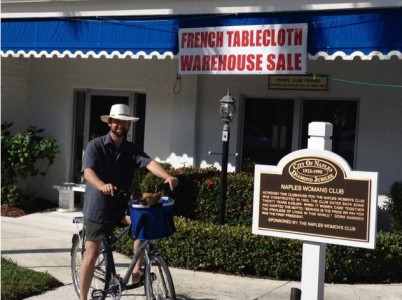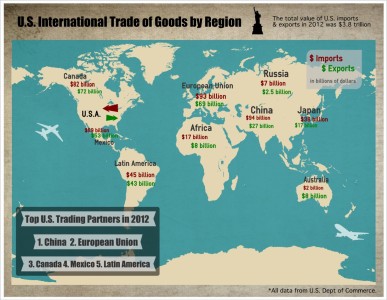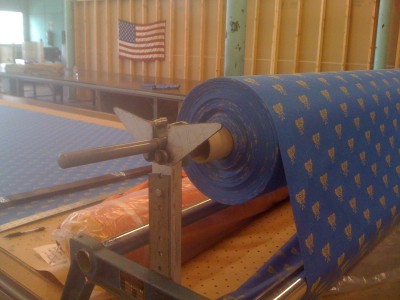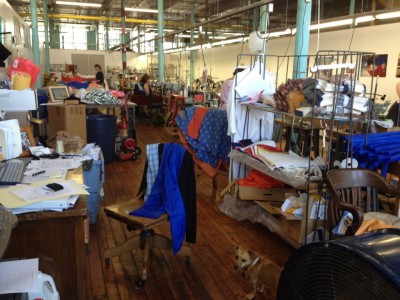When Michael Newburg, owner of a small Connecticut-based company selling imported French Provencal linens, decided to move production of his tablecloths from Europe to the U.S. he was surprised to find that his import duties went up
“I couldn’t understand it,” said Mr. Newburg. “The cost of bringing the raw material home was more than bringing in the finished product. It occurred to me this wasn’t good for job growth.”

Michael Newburg, owner of tablecloth company Amelie Michel, with his dog Ben–the company mascot–in front of a warehouse sale in Florida.
What Mr. Newburg stumbled upon was a tariff inversion—when the duty rate for the finished good is lower than the duty rate of the component parts. So, when he imported $100,000 worth of finished tablecloths from France he paid $4,800 in duties. But once he decided to have the manufacturing done in the U.S., the cost of importing $100,000 in straight fabric went up to almost $6,000. It may not seem like a big difference but remember, he would still need to pay to have the tablecloths made.
If the United States and European Union can reach a free trade agreement, tariffs would be removed and Newburg’s problems would go away. Yet as the two economic entities get closer to beginning negotiations next month, issues in the fabric and clothing sector provide a glimpse into the challenges that lay ahead regarding tariff elimination and regulatory cohesion—two key objectives of the deal.
Talk about the Transatlantic Trade and Investment Partnership, as the agreement is officially known, started after President Obama’s State of the Union speech in February when he called for such a deal. The idea quickly caught fire and formal negotiations are expected to begin next month. On Thursday, the European Parliament gave its blessing but warned that they needed to be kept fully on board with the talks, according to a news release.
“This resolution should now be duly taken into account by the Council and the Commission, as Parliament will only give its final consent if we have a positive outcome for our businesses, workers and citizens,” said Vital Moreira, a member of parliament from Portugal, who was appointed to report on the proceedings.
One American export with great growth potential is women’s designer jeans. U.S. denim manufacturers sold 1.73 million pairs of jeans worth $30.3 million to Europe in 2012, according to a report from the American Apparel and Footwear Association. In the first two months of 2013, the latest data available, U.S. jeans exports to Europe shot up 45.7 percent, the report said.
But U.S. manufacturers were recently slapped with a surprise tax hike from Europe on women’s denim, causing concern that the move could stall trade negotiations. The increase, from 12 percent to 38 percent, effectively prices many American-made jeans out of the important European market. As of May 1, a pair of True Religion jeans, when sold in Europe, went from $200 to $252, because of this penalty.
“The EU action is a real blow to the made-in-USA denim business,” said Steve Lamar, executive vice president of the American Apparel and Footwear Association. “It basically tells our manufacturers to go offshore to make jeans. It is especially troubling that this occurred right on the eve of the U.S. – European trade talks. Potential free trade partners don’t start the discussion by jacking up prices on each other’s exports.”
The harsh increase is meant to punish U.S. companies for receiving pay-outs under an invalid law, according to Lamar. The Byrd Amendment, repealed in 2005, offered opportunities for U.S. companies to seek monetary compensation from punitive duties being paid on products “dumped” in the U.S. market. The amendment started being phased out in 2007 but the government is still making payments.
“It is hard to believe that at a time of yawning budget deficits we are still making these payments under a program that is no longer supposed to exist,” he said. “Bottom line: we are asking policymakers on both sides of the Atlantic to find ways to remove this damaging new tariff immediately.”
The denim issue aside, there is European support for the idea of relinquishing tariffs and harmonizing regulation. The E.U. trade commissioner, Karel De Gucht, offered encouragement for the deal at a recent meeting in Strasbourg, France, and sited the car industry as a sector expected to see significant gains. He noted automobile manufacturers like BMW have long rankled at tariffs.
“The real challenge for both sides is to tackle the many ‘behind the border’ barriers to trade that exist within regulations or domestic standards,” said De Gucht in a statement. “We need to cut down on the red-tape and improve the way we regulate which often creates double costs for our companies.”
Whether or not that’s possible could have significant consequences on economic growth for both parties. Data from the U.S. Census and European Commission show a combined population of about 800 million people, 45 percent of the world’s GDP and 30 percent of global trade. A U.S.-EU trade agreement could increase annual GDP growth in the United States by up to 1.5 percent, according to estimates from the Hellenic American Leadership Council. Total U.S. economic growth was about 2 percent in 2012.
Currently, textile and apparel regulations between the U.S. and EU do not match in any way, said Nate Herman of the American Apparel and Footwear Association.
“This fact is a real deterrent for small manufacturers,” he said. “They don’t have the manpower to deal with all the regulations.”
At issue are burdensome customs documentation, provisions for exports and imports of silk, cotton and other fabrics considered flammable, warnings about chemical content, security requirements and labeling information.
“The information that has to be included on the label is more extensive in the U.S. than in the EU,” Luisa Santos, head of international trade at Euratex, the European textile and apparel association, said in a press release.
For instance, the U.S. requires the name of the manufacturer, importer and country of origin on all labeling. Similar requirements have only been recently proposed in the EU.
When it comes to safety and consumer protection, the U.S. has its own legislation that varies from the EU, including testing requirements.
Finding common ground on these and other issues in the fabric and clothing sector will take a tremendous amount of political will. A powerful incentive may come from the search for ways to kick the recession in both the U.S. and Europe into a higher gear and recognition that more and more manufacturing is being done on a small scale. But any economic stimulus that might come from the agreement is still years away.
“Trade agreements go through three stages: negotiation, passage and implementation,” said Nicole Bivens Collinson, president of trade negotiations and legislative affairs at Sandler, Travis & Rosenberg law firm. “Negotiation is the easy part.”
Despite the tax increase and uncertainty over the free trade agreement, Newburg did decide to have his tablecloths made in the U.S. He uses a small company that operates out of his warehouse in Fall River, Massachusetts for the production.
“Having the work done here is actually much easier for me,” he said.







